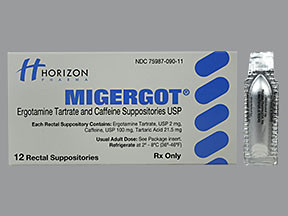ERGOTAMINE/CAFFEINE - RECTAL
PHONETIC PRONUNCIATION: (er-GOT-uh-meen/KAF-een)
COMMON BRAND NAME(S): Cafergot, Migergot
GENERIC NAME(S): ergotamine tartrate/caffeine
Uses
USES: This combination medication is used to treat or prevent a certain type of headache (vascular headaches such as migraine headaches and cluster headaches). Ergotamine helps narrow widened blood vessels in the head, which reduces the throbbing effects of vascular headaches. Caffeine increases the effects of ergotamine by also narrowing the widened blood vessels in the head. The suppository form is used when medications cannot be taken by mouth (e.g., due to nausea and vomiting).
How to use ERGOTAMINE/CAFFEINE - RECTAL
HOW TO USE: Unwrap and insert one suppository rectally as directed by your doctor. Remain lying down for a few minutes, and avoid having a bowel movement for an hour or longer so the drug will be absorbed. The suppository is for rectal use only. If the suppository is exposed to heat and softens, chill in ice-cold water before unwrapping and using the suppository. Dosage is based on your medical condition and response to therapy. This medication works best if it is used as the first signs of the headache occur. If you wait until the headache has worsened, the medication may not work as well. This medication usually should be used only as needed. It is not meant for long-term daily use. The maximum dose is 2 suppositories for a single headache attack and 5 suppositories in any 7-day period. This medication may cause withdrawal reactions, especially if it has been used regularly for a long time (more than a few weeks) or in high doses. In such cases, rebound headaches may occur if you suddenly stop using this medication. This headache may be different from your original headache and may last a few days. Report any such headaches to your doctor right away. Consult your doctor or pharmacist for more details. If you are using drugs for migraine attacks on 10 or more days each month, the drugs may actually make your headaches worse (medication overuse headache). Do not use medications more often or for longer than directed. Tell your doctor if you need to use this medication more often, or if the medication is not working as well, or if your headaches get worse.
Side Effects
Precautions
Interactions
Overdose
Images
Reviews
Faq for ERGOTAMINE/CAFFEINE - RECTAL
Ergotamine/Caffeine rectal is used for the treatment of acute migraine headaches with or without aura. It helps relieve migraine symptoms such as headache, nausea, vomiting, and sensitivity to light and sound.
Ergotamine works by narrowing the blood vessels in the brain, reducing the pulsation and intensity of migraine headaches. Caffeine enhances the effect of ergotamine and helps it to be absorbed more quickly.
Ergotamine/Caffeine rectal comes in the form of suppositories that are inserted into the rectum. The recommended dose is usually one suppository at the start of a migraine attack, with a second suppository if needed after one hour, but not exceeding a maximum of two suppositories in a 24-hour period.
Common side effects of Ergotamine/Caffeine rectal may include nausea, vomiting, stomach pain, tingling or numbness in the fingers or toes, cold or blue hands or feet, and itchy or flushed skin. These side effects are usually mild and subside on their own.
No, Ergotamine/Caffeine rectal is not intended for use as a preventive medication. It is specifically used for the treatment of acute migraine attacks when they occur.
Yes, Ergotamine/Caffeine rectal should not be used by individuals with uncontrolled high blood pressure, heart disease, peripheral vascular disease, liver or kidney problems, history of stroke or transient ischemic attack (TIA), or those who are allergic to ergotamine or other similar medications. It is important to consult a healthcare professional before using this medication.
Ergotamine/Caffeine rectal is not recommended for use in children under the age of 18 unless specifically prescribed by a pediatrician. The safety and effectiveness of this medication in pediatric patients have not been established.
Warning
WARNING: This medication has rarely caused a very serious lack of blood flow to the hands and feet (peripheral ischemia) or to the brain, which could cause a stroke. The risk is increased when this medication is taken with other drugs that can affect the removal of ergotamine from your body. Examples include azole antifungals (such as ketoconazole, itraconazole), boceprevir, cobicistat, mifepristone, telaprevir, certain antidepressants (such as nefazodone), macrolide antibiotics (such as clarithromycin, erythromycin, troleandomycin), HIV NNRTIs (such as delavirdine), HIV protease inhibitors (such as ritonavir, nelfinavir, indinavir), SSRIs (such as fluoxetine, paroxetine, fluvoxamine), among others.
Disclaimer
IMPORTANT: HOW TO USE THIS INFORMATION: This is a summary and does NOT have all possible information about this product. This information does not assure that this product is safe, effective, or appropriate for you. This information is not individual medical advice and does not substitute for the advice of your health care professional. Always ask your health care professional for complete information about this product and your specific health needs.

No Reviews Yet